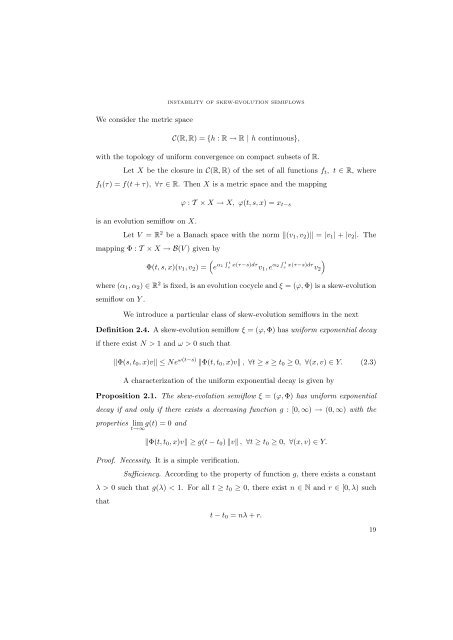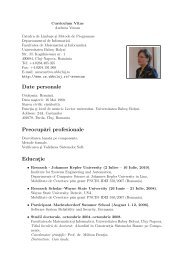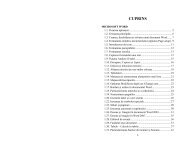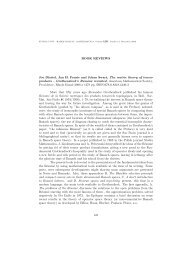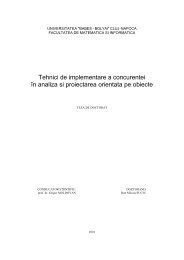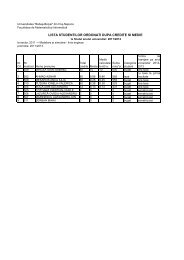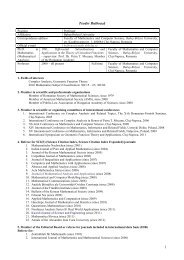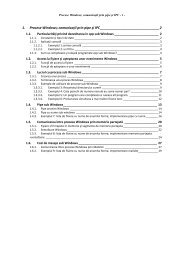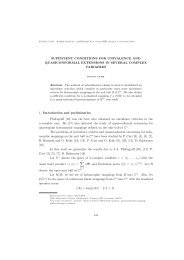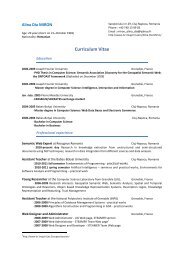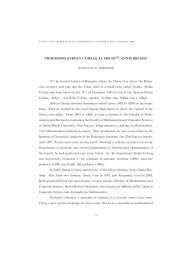EXPONENTIAL INSTABILITY OF SKEW-EVOLUTION ... - UBB Cluj
EXPONENTIAL INSTABILITY OF SKEW-EVOLUTION ... - UBB Cluj
EXPONENTIAL INSTABILITY OF SKEW-EVOLUTION ... - UBB Cluj
You also want an ePaper? Increase the reach of your titles
YUMPU automatically turns print PDFs into web optimized ePapers that Google loves.
We consider the metric space<br />
<strong>INSTABILITY</strong> <strong>OF</strong> <strong>SKEW</strong>-<strong>EVOLUTION</strong> SEMIFLOWS<br />
C(R, R) = {h : R → R | h continuous},<br />
with the topology of uniform convergence on compact subsets of R.<br />
Let X be the closure in C(R, R) of the set of all functions ft, t ∈ R, where<br />
ft(τ) = f(t + τ), ∀τ ∈ R. Then X is a metric space and the mapping<br />
is an evolution semiflow on X.<br />
ϕ : T × X → X, ϕ(t, s, x) = xt−s<br />
Let V = R 2 be a Banach space with the norm �(v1, v2)� = |v1| + |v2|. The<br />
mapping Φ : T × X → B(V ) given by<br />
Φ(t, s, x)(v1, v2) =<br />
�<br />
e α1<br />
� t<br />
s x(τ−s)dτ v1, e α2<br />
� t<br />
s x(τ−s)dτ v2<br />
where (α1, α2) ∈ R 2 is fixed, is an evolution cocycle and ξ = (ϕ, Φ) is a skew-evolution<br />
semiflow on Y .<br />
We introduce a particular class of skew-evolution semiflows in the next<br />
Definition 2.4. A skew-evolution semiflow ξ = (ϕ, Φ) has uniform exponential decay<br />
if there exist N > 1 and ω > 0 such that<br />
�Φ(s, t0, x)v� ≤ Ne ω(t−s) �Φ(t, t0, x)v� , ∀t ≥ s ≥ t0 ≥ 0, ∀(x, v) ∈ Y. (2.3)<br />
A characterization of the uniform exponential decay is given by<br />
Proposition 2.1. The skew-evolution semiflow ξ = (ϕ, Φ) has uniform exponential<br />
decay if and only if there exists a decreasing function g : [0, ∞) → (0, ∞) with the<br />
properties lim<br />
t→∞ g(t) = 0 and<br />
�Φ(t, t0, x)v� ≥ g(t − t0) �v� , ∀t ≥ t0 ≥ 0, ∀(x, v) ∈ Y.<br />
Proof. Necessity. It is a simple verification.<br />
Sufficiency. According to the property of function g, there exists a constant<br />
λ > 0 such that g(λ) < 1. For all t ≥ t0 ≥ 0, there exist n ∈ N and r ∈ [0, λ) such<br />
that<br />
t − t0 = nλ + r.<br />
�<br />
19


